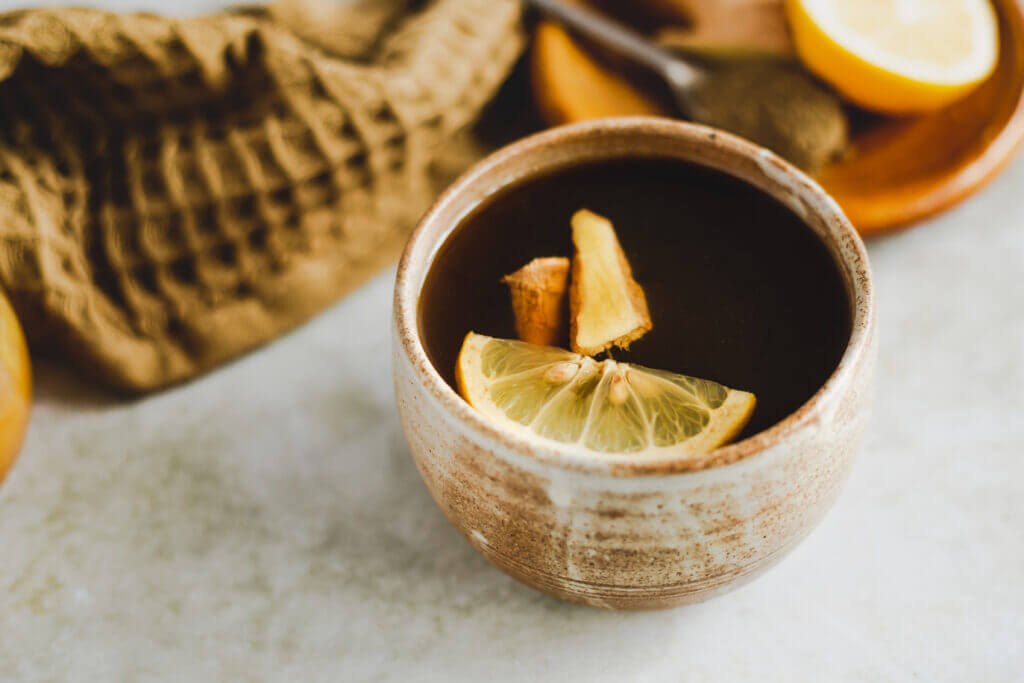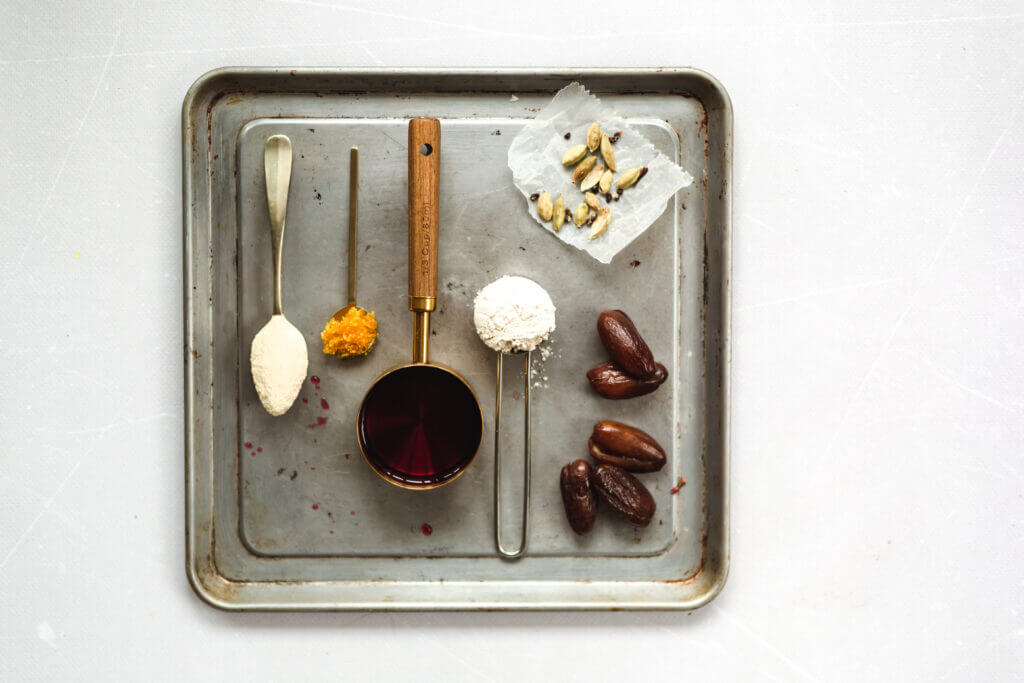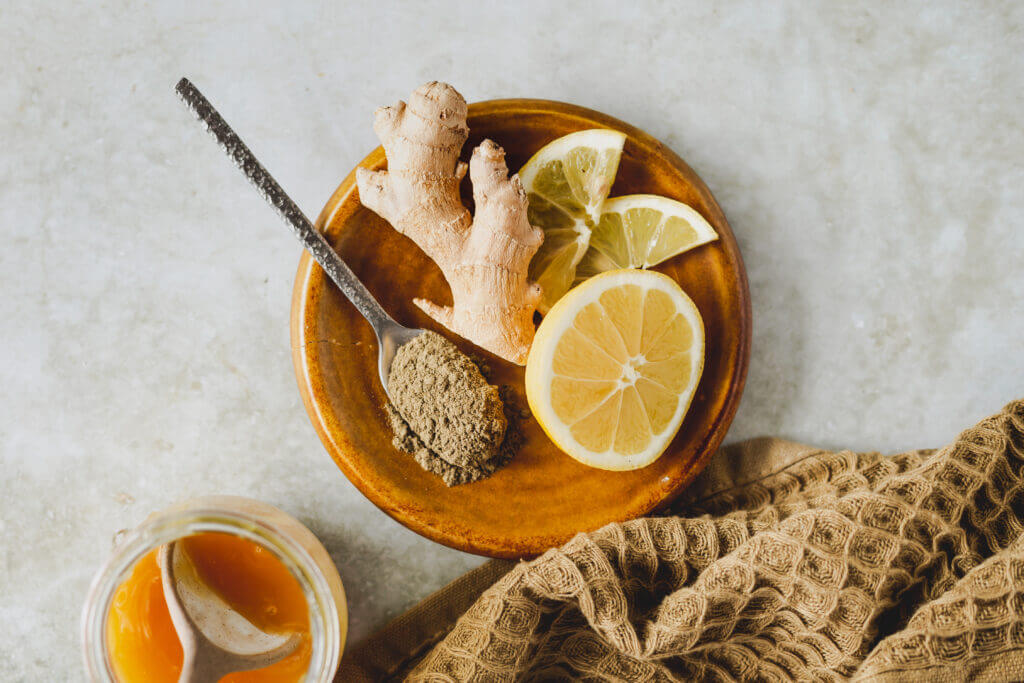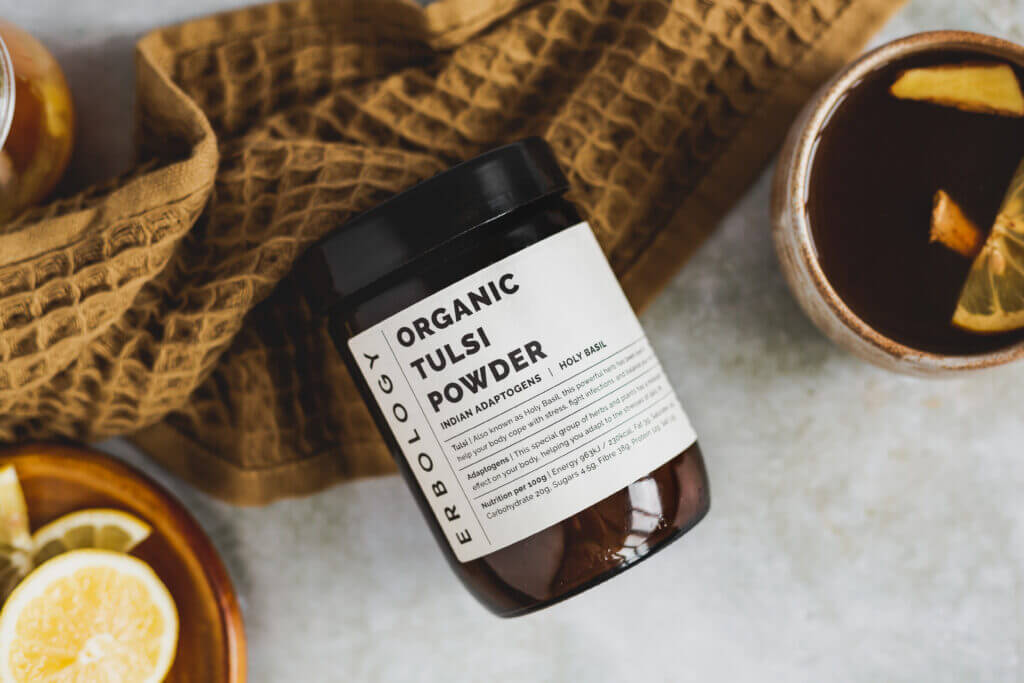Tulsi tea recipe with ginger and lemon
- 1
Serving

Prep Time 2'

Total Time 3'

Easy

Vegan
- 1
Serving

Prep Time 2'

Total Time 3'

Easy

Vegan
We have all probably tasted basil, the sweet, fragrant archetypal Italian herb suggestive of tricolore salad with its sun-ripened tomatoes and mozzarella cheese. But, what is holy basil, and what are holy basil tea benefits? Some chefs even suggest that the authentic trifecta, or Holy Trinity, of Italian cooking is actually basil, tomato and garlic! Step aside traditional battuto, you may think, made by sweating onions, with crisp celery and crunchy carrots. Many regions around the world have their own trifecta or Holy Trinity of flavours which are key to their unique cuisines.
Holy basil - the 'Queen of Herbs'
Tulsi, also known as holy basil, comes from the basil family Lamiaceae (tribe ocimeae). The family includes mint, sage, oregano, rosemary, and lavender. Tulsi is a herb cultivated for its desirable qualities such as aromatics, pungency, and healing properties. It is believed that tulsi first took hold in North Central India. However, it now grows abundantly in the East, in areas surrounding the Equator. Tulsi's broad-spectrum activity has earned it praise as the "elixir of life" for its apparent medicinal and spiritual benefits. For example, Ayurvedic medicine refers to tulsi as "The Queen of Herbs", "The Incomparable One", and "Mother Medicine of Nature". Consumption of tulsi tea has even been compared with the practice of yoga, considered “adaptogenic” through nurturing, nourishing, mind-body-spirit practices that foster wellbeing. 
Is tulsi tea adaptogenic?
An adaptogen has the ability to read our bodies and adapt to what they need at the given moment. Amazing! Widely used in the Ayurvedic tradition, tulsi tea is adaptogenic. Think of it this way: a plant can lift you up or calm you down. The term ‘adaptogen’ was coined in the 1950s by Russian scientist Lazarev. The term groups plants and herbs that have been used medically for thousands of years and are only now gaining traction in the West. This is because of their ability to impact on our stress levels - a growing problem. Calling a plant an adaptogen, however, requires knowledge. Here are some of the criteria a plant must meet in order to be classed as one. First, adaptogens must work in a general way. For instance, they must be able to help ward off stress from any type of source. This includes environmental stress, physical illness, unhealthiness, and even emotional stress caused by interaction with others. Second, adaptogens must be able to help people get back into ‘balance’ and retain equilibrium. Finally, adaptogens must not affect, or disrupt, the other functions of our bodies. This definition, however, may fluctuate. Additionally, as a potent antioxidant rich in chlorophyll, essential oils, and other nutrients, tulsi tea can fight oxidative damage. Its peppery, zesty, and sometimes slightly sweet taste, means it can be relaxing or invigorating. To summarise, tulsi tea can help with physical and mental stress, balance your mood, increase endurance and fight infection. 
Herbal teas in traditional medicine
Think of all herbs as on the cusp, or crossover, between food and medicine. We have evolved in tandem with a vast botanical pharmacy of herbs which for millennia have been cultivated for their medicinal and culinary properties. Moreover, spices and herbs still have their place in medicine; especially in India and China where their healing properties enjoy great respect. Prevention of disease, rather than cure, is the key. There are many ways to take herbs, the most common being water extraction. Imagine a steamy cup of herbal tea, and your senses will be assaulted by the warmth, flavours, fragrances of the herbs, and may even elicit a memory or two. In other words, brewing and drinking herbal teas for health and serenity is an ancient tradition ingrained into the fabric of our humanity. Herbal teas were among our first medicines and holy basil, or tulsi tea, is no exception. 
Ayurveda and Traditional Chinese Medicine
Firstly, Ayurveda, with its roots in India, and Traditional Chinese Medicine (TCM) are two of the world’s oldest medical systems. Their approach to health and illness is holistic and focused on disease prevention and boosting health. Most importantly, both systems encourage lifestyle choices to attain health and balance in life. Practices include eating wholefoods, movement and meditation, as well as avoiding processed foods. Ayurveda relies heavily on medicinal herbs due to the unique and rich biodiversity of its country of origin, India. While, TCM focuses on the whole person and instead of body parts you may hear practitioners speak of life forces such as the universal energy known as Qi. According to Taoist cosmology, which is fundamental to TCM, Qi exists in the body, on earth, and in the heavens. It animates life and growth, powers movement and effects change. Qi, in the body, is energy and movement - a little like electricity - and production depends on the food we eat and the air we breathe. According to TCM, there are complementary life forces in all of us. They are ‘yin’, the passive life force, and ‘yang’, an active life force. When in balance and harmonious we feel healthy and well. TCM has an arsenal of methods to help correct imbalances when they occur. These range from herbal remedies, to treatments such as acupuncture, cupping, and the movement practice of Qigong.
What is tulsi tea in Ayurveda?
As far as Ayurveda’s holistic approach to health and wellbeing goes, tulsi is probably one of the most representative examples of this eastern medical system. Every part of the tulsi plant is thought to be healing. Moreover, you can prepare it in various ways to benefit from its different health benefits. Tulsi is naturally bitter and hot, believed to reach deep tissues and balance Ayurvedic doshas (the energy patterns that Ayurvedic medicine believes flow through the body). It appears that according to Ayurveda, tulsi can alleviate a host of ailments from anxiety, asthma, diarrhoea, arthritis, indigestion, and even fever. The scientific jury, however, is still out on some of these claims.
The spiritual meaning of holy basil
The history of tulsi is tied to a strong religious and spiritual meaning in India. For instance, tulsi is sacred to Hindu people, who believe that the soil it grows in will become richer and more fertile. Lore has it as the earthly expression of Lakshmi, and as such it can bestow many blessings. In one legend, tulsi was thought as an earthly manifestation of Lakshmi, goddess of wealth and wife of the Hindu god Vishnu. She was his favourite wife of three. Gripped by jealousy, the other two cursed Lakshmi, driving her into the earth as a plant. Vishnu rescued her as the tulsi plant, with her roots in the soil and her spirit rising to mingle with his! Another legend has Vishnu weeping into the elixir of immortality; his tears of joy spill into the elixir and they birth the tulsi plant. Householders who worship the god Vishnu also wear beaded prayer necklaces made of tulsi stems, and its petals are used in funeral as well as wedding ceremonies. Tulsi is thus a venerated plant in India and you will find it growing in the home of many Hindus. 
How to make tulsi tea
Whatever legend resonates, how to make tulsi tea is more straightforward than all of them. The leaves of the tulsi plant, or holy basil, are serrated and look like a cross between basil and mint. They are commonly used as a tea or infusion. Much like many other herbal infusions, you can use fresh or dried leaves, and steep them in hot water. We like to use Organic Tulsi Powder to make a perfect caffeine-free infusion. You can use a little at a time and store in a dark place at room temperature for continued freshness! Tulsi can have a strong scent along with an astringent, somewhat bitter flavour. However, given that it is part of the basil family, it also has notes of flowers and pepper. Some varieties may have a clove-like scent and spicy aroma; others are more fresh and citrusy. When making a tulsi tea recipe make sure you don’t mistaken holy basil for other types of basil! There are several types of holy basil, too. The most common are Krishna tulsi (black or purple in colour) and white Vana, or wild tulsi. Of the two, Krishna tulsi is higher in antioxidants.
Tulsi tea with ginger and honey
Firstly, to make our tulsi tea recipe, use our 100% organic tulsi powder. Try 200ml filtered hot water to 1/2 tsp Erbology Tulsi Tea Powder. To this add one teaspoon of raw honey or two drops of stevia. The addition of raw honey will boost the healing properties of our tea. Raw honey comes straight from the beehive, and as such contains healthy bee propolis and antioxidants. Usually, the darker the colour of the honey the greater the nutritional value in antioxidants, minerals and trace elements. You could also add two drops of stevia instead of the honey. Stevia comes from a plant that is native to South America, where it has been used for hundreds of years. With increased rates of chronic diseases, such as obesity and diabetes, natural sweeteners such as stevia are gaining traction.(1) Adding ginger, related to cardamom, galangal and turmeric, will deepen the flavour and lemon will add a beautiful balance. Ginger is known for its documented healing properties. It has, for instance, been used for over 200 years in TCM as a spice and medicine. It has long been used to treat ailments from colds and flu to rheumatism.
To recap, what is tulsi tea good for?
So, what is tulsi tea good for, you may ask? Maybe the question should be what is it not good for! In terms of health products, you can find tulsi as a tea, tincture, supplement, or as a powder. But what exactly can it do for our health?
- It is thought that like the practice of yoga, tulsi has a calming effect that might lead to clarity of thought, along with a more relaxed disposition. So, it can be memory enhancing without the crash of caffeine - or some of the nasty pesticide additives, unless the coffee is organic.
- Tulsi can be consumed as regularly as wanted without any nasty side-effects such as the shakes or racing pulse! Doing so, according to Ayurvedic followers, may even foster beauty, intelligence and stamina.
- Add to this its effect on mood, increased endurance, infection fighting and its moniker as the “elixir of life,” is plausible!
Move over summer
Shorter days and nights, the turning leaves on the trees and the bite in the air signal our need to draw in, and replenish as the heat and energy of the summer ebbs. There can be few better ways to replenish than with a steaming mug of tulsi tea with ginger and lemon. As you taste this “elixir,” you may even imagine the taste of the god Vishnu’s tears mingling with the herbs and spices, and the measureless love for his goddess Lakshmi!
Ingredients
- ½ tsp Erbology Organic Tulsi Tea Powder
- 200ml hot boiling water
- 1 tsp raw honey or 2 drops stevia
- 2 slices of fresh ginger
- Half slice of a lemon
Typical nutrition / serving
- Serv. size: 200 g
- Serv. size text: 40 g
- Servings: 1 g
- Cholesterol: 12 mg
- Fiber: 0.3 g
Here's how you make it
- Place tulsi tea powder in a cup and add hot boiling water. Let steep for 3 to 4 minutes.
- Strain and transfer to a serving cup. Add honey, ginger and lemon and serve. Enjoy!
If you tried this recipe...
Share your experience with us. Leave a comment below or post a picture on Instagram, tag @erbologyofficial #erbology and get a chance to win a healthy treat from us.